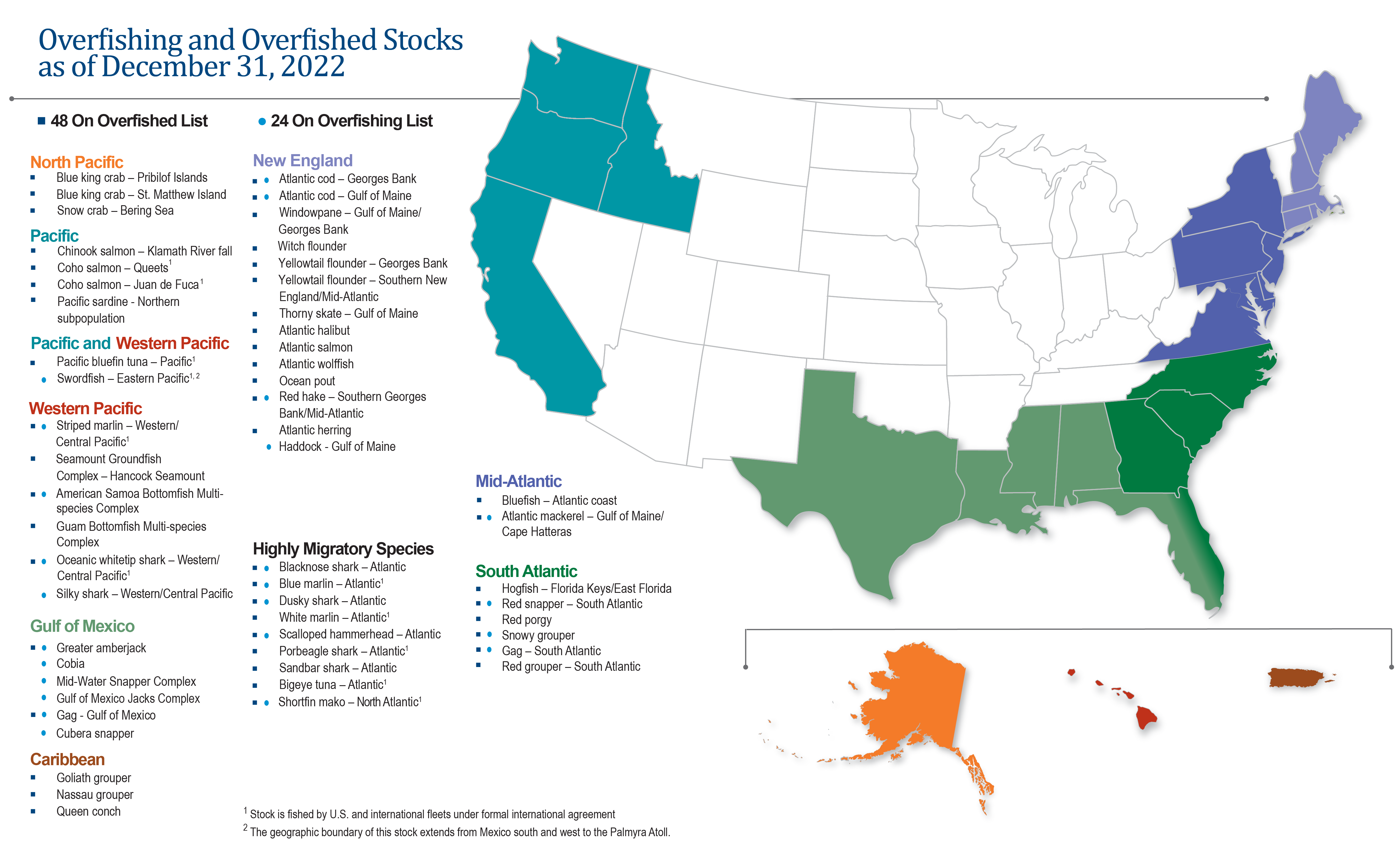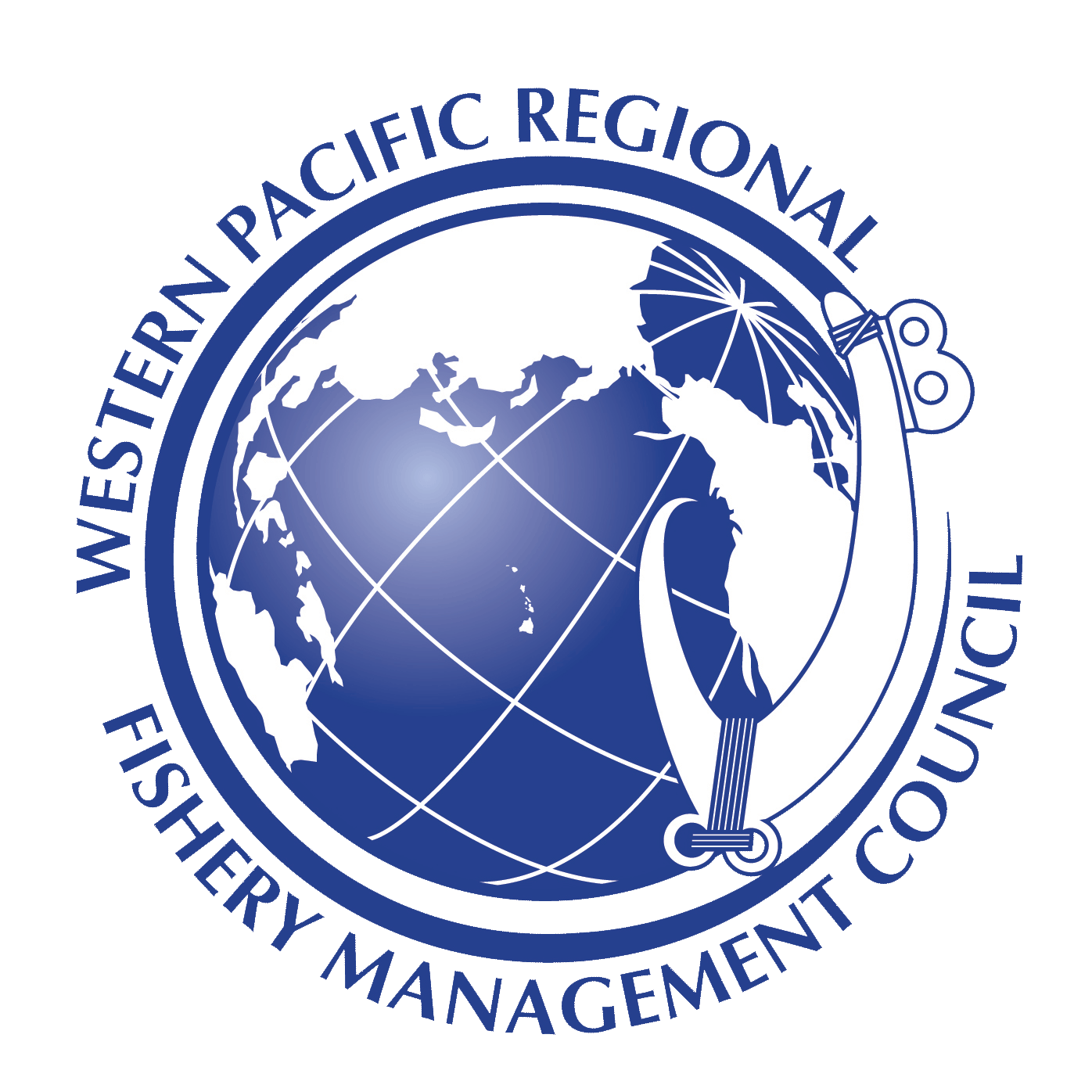|
Magnuson–Stevens Fishery Conservation And Management Act
The Magnuson–Stevens Fishery Conservation and Management Act (MSFCMA), commonly referred to as the Magnuson–Stevens Act (MSA), is the legislation providing for the management of marine fisheries in U.S. waters. Originally enacted in 1976 to assert control of foreign fisheries that were operating within 200 nautical miles off the U.S. coast, the legislation has since been amended, in 1996 and 2007, to better address the twin problems of overfishing and overcapacity (i.e., too much fishing power). These ecological and economic problems arose in the domestic fishing industry as it grew to fill the vacuum left by departing foreign fishing fleets. Eight regional fishery management councils, composed of representatives of the fishing industry and state fishery officials, prepare fishery management plans for approval and implementation by the National Marine Fisheries Service (NMFS), which is an agency within the National Oceanic and Atmospheric Administration (NOAA), a part of th ... [...More Info...] [...Related Items...] OR: [Wikipedia] [Google] [Baidu] |
Conservation
Conservation is the preservation or efficient use of resources, or the conservation of various quantities under physical laws. Conservation may also refer to: Environment and natural resources * Nature conservation, the protection and management of the environment and natural resources **Wetland conservation, protecting and preserving areas where water exists at or near the Earth's surface, such as swamps, marshes and bogs. * Conservation biology, the science of protection and management of biodiversity * Conservation movement, political, environmental, or social movement that seeks to protect natural resources, including biodiversity and habitat * Conservation organization, an organization dedicated to protection and management of the environment or natural resources * Wildlife conservation, the practice of protecting wild species and their habitats in order to prevent species from going extinct * ''Conservation'' (magazine), published by the Society for Conservation Biolog ... [...More Info...] [...Related Items...] OR: [Wikipedia] [Google] [Baidu] |
Bill (law)
A bill is a proposal for a new law, or a proposal to substantially alter an existing law. A bill does not become law until it has been passed by the legislature and, in most cases, approved by the executive. Bills are introduced in the legislature and are there discussed, debated on, and voted upon. Once a bill has been enacted into law by the legislature, it is called an '' act of the legislature'', or a ''statute''. Usage The word ''bill'' is mainly used in English-speaking nations formerly part of the British Empire whose legal systems originated in the common law of the United Kingdom, including the United States. The parts of a bill are known as ''clauses'', until it has become an act of parliament, from which time the parts of the law are known as ''sections''. In nations that have civil law systems (including France, Belgium, Luxembourg, Spain and Portugal), a proposed law is known as a "law project" (Fr. ''projet de loi'') if introduced by the government, or a " ... [...More Info...] [...Related Items...] OR: [Wikipedia] [Google] [Baidu] |
Congress
A congress is a formal meeting of the representatives of different countries, constituent states, organizations, trade unions, political parties, or other groups. The term originated in Late Middle English to denote an encounter (meeting of adversaries) during battle, from the Latin '' congressus''. Political congresses International relations The following congresses were formal meetings of representatives of different nations: *The Congress of Aix-la-Chapelle (1668), which ended the War of Devolution *The Congress of Aix-la-Chapelle (1748), which ended the War of the Austrian Succession *The Congress of Aix-la-Chapelle (1818) *The Congress of Berlin (1878), which settled the Eastern Question after the Russo-Turkish War (1877–1878) *The Congress of Gniezno (1000) *The Congress of Laibach (1821) *The Congress of Panama, an 1826 meeting organized by Simón Bolívar *The Congress of Paris (1856), which ended the Crimean War *The Congress of Troppau (1820) *The Congr ... [...More Info...] [...Related Items...] OR: [Wikipedia] [Google] [Baidu] |
United States Statutes At Large
The ''United States Statutes at Large'', commonly referred to as the ''Statutes at Large'' and abbreviated Stat., are an official record of Acts of Congress and concurrent resolutions passed by the United States Congress. Each act and resolution of Congress is originally published as a slip law, which is classified as either public law (abbreviated Pub.L.) or private law (Pvt.L.), and designated and numbered accordingly. At the end of a congressional session, the statutes enacted during that session are compiled into bound books, known as "session law" publications. The ''United States Statutes at Large'' is the name of the session law publication for U.S. Federal statutes. The public laws and private laws are numbered and organized in chronological order. U.S. Federal statutes are published in a three-part process, consisting of slip laws, session laws (''Statutes at Large''), and codification (''United States Code''). Codification Large portions of public laws are enac ... [...More Info...] [...Related Items...] OR: [Wikipedia] [Google] [Baidu] |
United States Government Publishing Office
The United States Government Publishing Office (USGPO or GPO), formerly the United States Government Printing Office, is an agency of the legislative branch of the United States federal government. The office produces and distributes information products and services for all three branches of the Federal Government, including U.S. passports for the Department of State as well as the official publications of the Supreme Court, the Congress, the Executive Office of the President, executive departments, and independent agencies. An act of Congress changed the office's name to its current form in 2014. History Establishment of the Government Printing Office The Government Printing Office was created by congressional joint resolution () on June 23, 1860. It began operations March 4, 1861, with 350 employees and reached a peak employment of 8,500 in 1972. The agency began transformation to computer technology in the 1980s; along with the gradual replacement of paper with el ... [...More Info...] [...Related Items...] OR: [Wikipedia] [Google] [Baidu] |
Sustainable Fisheries
A conventional idea of a sustainable fishery is that it is one that is harvested at a sustainable rate, where the fish population does not decline over time because of fishing practices. Sustainability in fisheries combines theoretical disciplines, such as the population dynamics of fisheries, with practical strategies, such as avoiding overfishing through techniques such as Individual fishing quota, individual fishing quotas, curtailing destructive fishing practices, destructive and Illegal, unreported and unregulated fishing, illegal fishing practices by lobbying for appropriate law and policy, setting up protected areas, restoring collapsed fisheries, incorporating all externality, externalities involved in harvesting marine ecosystems into fishery economics, educating stakeholders and the wider public, and developing independent certification programs. Some primary concerns around sustainability are that heavy fishing pressures, such as overexploitation and Growth overfishing, g ... [...More Info...] [...Related Items...] OR: [Wikipedia] [Google] [Baidu] |
South Atlantic Fishery Management Council
The eight U.S. regional fishery management councils are the primary forums for developing conservation and management measures for U.S. marine fisheries. The regional councils recommend management measures for fisheries in the Exclusive Economic Zone (EEZ); which are subject to approval and implemented by the National Marine Fisheries Service (NMFS). The councils were established by the Magnuson-Stevens Fishery Conservation and Management Act in 1976. In 1996, revisions to the laws governing the regional fishery management councils were made by the Sustainable Fisheries Act, which includes provisions to reduce bycatch, consider the effects of management decisions on communities, and protect essential fish habitats. The councils are composed of individuals with a stake in the fishery. This includes federal and state officials, primarily from the National Marine Fisheries Service and the Fish and Wildlife Service. Additionally, councils have at-large and obligatory members sel ... [...More Info...] [...Related Items...] OR: [Wikipedia] [Google] [Baidu] |
North Pacific Fishery Management Council
The North Pacific Fishery Management Council (NPFMC) is one of eight regional councils established by the Magnuson–Stevens Fishery Conservation and Management Act in 1976 to manage the fisheries of the United States. With jurisdiction over the Exclusive Economic Zone (EEZ) off Alaska, the Council has primary responsibility for groundfish management in the Gulf of Alaska, Bering Sea and Aleutian Islands, including cod, pollock, flatfish, mackerel, sablefish, and rockfish species. Other large Alaska fisheries such as salmon, crab and herring are managed primarily by the State of Alaska. Community Development Program Quotas The Western Alaska Community Development Quota (CDQ) Program was created by the Council in 1992 to provide western Alaska communities an opportunity to participate in the Bering Sea and Aleutian Islands (BSAI) fisheries that had been foreclosed to them because of the high capital investment needed to enter the fishery. The purpose of the CDQ Program is to: *to pr ... [...More Info...] [...Related Items...] OR: [Wikipedia] [Google] [Baidu] |
Western Pacific Regional Fishery Management Council
The Western Pacific Regional Fishery Management Council (WPRFMC) is one of eight regional councils established under the Magnuson-Stevens Fishery Conservation and Management Act (MSA) in 1976 to manage offshore fisheries. The WPRFMC's jurisdiction includes the US exclusive economic zone (EEZ) waters (generally 3–200 miles offshore) around the State of Hawaii; US Territories of American Samoa and Guam; the Commonwealth of the Northern Mariana Islands (CNMI); and the US Pacific remote island areas of Johnston, Midway, Palmyra and Wake Atolls; Baker, Howland and Jarvis Islands; and Kingman Reef. This area of nearly 1.5 million square miles is the size of the continental United States and constitutes about half of the entire US EEZ. It spans both sides of the equator and both sides of the dateline. The WPRFMC also manages domestic fisheries based in the US Pacific Islands that operate on the high seas. The council is based in Honolulu, Hawaii. Achievements * In 1983, thru the Pre ... [...More Info...] [...Related Items...] OR: [Wikipedia] [Google] [Baidu] |
National Academy Press
The US National Academies Press (NAP) was created to publish the reports issued by the National Academies of Sciences, Engineering, and Medicine (formerly known as the National Research Council (United States), National Research Council), the National Academy of Engineering, National Academy of Sciences, National Academy of Engineering, and the National Academy of Medicine. It publishes nearly 500 titles a year on a wide range of topics in the sciences, engineering, medicine, and transportation . The NAP's stated mission is seemingly self-contradictory: to disseminate as widely as possible the works of the National Academies of Sciences, Engineering, and Medicine, and to be financially self-sustaining through sales. This mission has led to great experimentation in openness regarding online publishing and open access. The National Academy Press, as it was known in 1993, was the first self-sustaining publisher to make its material available on the Web, for free, in an open access m ... [...More Info...] [...Related Items...] OR: [Wikipedia] [Google] [Baidu] |
Sustainable Fisheries Act Of 1996
The Sustainable Fisheries Act of 1996 is an amendment to the Magnuson-Stevens Fishery Conservation and Management Act, a law governing the management of marine fisheries in the United States. Another major amendment to this legislation was later made under the ''Magnuson-Stevens Fishery Conservation and Management Reauthorization Act of 2006''. The SFA was enacted to amend the outdated MSFCMA of 1976. The amendment included changes to the purpose of the act, definitions, and international affairs, as well as many small changes. The U.S. Senate bill S. 39 was passed by the 104th United States Congressional session and enacted into law by the 42nd President of the United States Bill Clinton on October 11, 1996. Purpose There were several major changes to the purpose of the law: # Prohibiting fisheries managers from using social, economic, or any other justifications to allow catch targets to exceed a calculated "maximum sustainable yield." # Mandating that for each managed specie ... [...More Info...] [...Related Items...] OR: [Wikipedia] [Google] [Baidu] |







